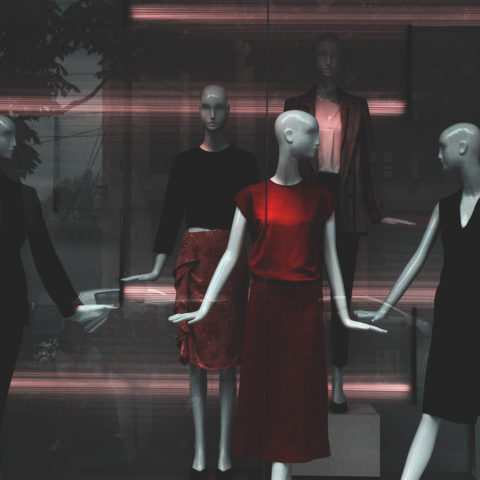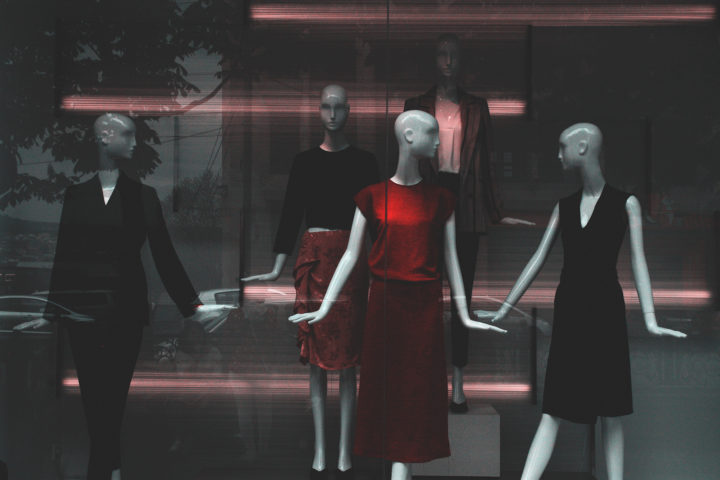
When we think of pollution, we tend to think of single issues like air pollution, water pollution, soil pollution, and the bottom line, the climate change that is exacerbated by the production process. But the fashion industry encompasses all of these — the “Four Horsemen” if you will. And it destroys lives.
The closet below is the one some people dream about, but it also represents an obsession that often can never be satisfied, an obsession driven by marketing and media, and fast fashion. Whereas the fashion cycle once consisted of spring and fall, it now churns out a new trend 50 times a year. The clothes are cheaply made, fall apart quickly, and are discarded in favor of the next new thing. A third of them end up in landfills. Almost as much ends up as stuffing for sofas and insulation. What’s left is sold as second-hand goods, both here and overseas.

The global fashion industry exploits the environment, as well as human workers. Most clothing is assembled in China, Bangladesh, and India, the main low and middle-income countries (LMICs) that produce 90 percent of clothing. The United States Environmental Protection Agency defines environmental justice as “fair treatment and meaningful involvement of all people regardless of race, color, national origin, or income, with respect to the development, implementation, and enforcement of environmental laws, regulations, and policies.” While with the establishment of textile labor unions in the early 1900s we have eliminated the sweatshops in our country, the same is not true in poorer countries where women and children are exploited and exposed to thousands of chemical toxins in the name of fashion. They are at risk from unsafe working conditions and the associated cancers and other threats to fetal, reproductive, and endocrine system health.
Global Fashion Agenda and The Boston Consulting Group published a 2017 report titled “Pulse of the Fashion Industry,” in which they project industry increases in water consumption, energy emissions, and waste creation from 2015 until 2030.
- Water consumption, measured in million cubic meters, rises from 79 to 118;
- Emissions of CO2, measured in million tons, rises from 1,715 to 2,791; and
- Waste creation, measured in million tons, rises from 92 to 148.

Approximately 90 percent of clothing sold in the United States is made with polyester or cotton. Cotton requires large amounts of pesticides. This crop uses approximately 25 percent of insecticides and 18 percent of all pesticides. It is a thirsty crop. The production of one cotton t-shirt requires as much water as a person would drink in about two and a half years—751 gallons.

The Aral Sea in central Asia has nearly disappeared because water from the Amu Darya and Syr Darya rivers has been drawn down, not for growing food, but for growing cotton. Pesticides run off fields and into water bodies. Water is fouled and wasted during production as well.
Synthetics present their own problems. Our oceans are filled with synthetic fibers, and these fibers enter our water systems every time we wash our clothing. In a paper titled “Quantifying shedding of synthetic fibers from textiles; a source of microplastics released into the environment,” the National Institutes of Health (NIH) reports the findings and concludes:
- Fleece fabric sheds significantly more fibers than other knits.
- PET fleece sheds an estimated 110,000 fibers per garment and wash.
- All fabrics shed fibers, but no significant difference was found between nylon, acrylic, and PET knits.
- More loosely knit textile construction resulted in greater fiber loss.
- Shedding of fibers can potentially be mitigated with smarter textile construction.
It’s not just about the water bottles. Approximately 20 percent of industrial water pollution is created by the manufacture of clothing. Globally we use more than 1 trillion gallons of water for the dyeing of fabric. We are drowning in textile waste.
In the United States we consume more of this output than in any other country. Nearly 4 billion pounds of it ends up in our landfills. This equals about 80 pounds for each American, every year. And yet the fashion industry churns on, raking in $1.2 trillion annually. But where is the uproar?

The fact is that we cannot absorb the quantity and quality of clothing that is discarded in this country. Approximately 500,000 tons of clothing that escapes the landfill is exported yearly to LMICs, many in Africa. Upon arrival, it is graded and sorted and sold in second-hand markets.
Planet Aid collects clothing in metal boxes they place in public places, but they are clear that this clothing is not donated to the needy. “Most of the clothing we receive is loaded directly into our baling machine without sorting. The baling machine wraps the clothes in a protective cloth or plastic wrapper and straps them tightly together into a large package that weighs approximately 1,000 pounds. These bales make it easier to handle and ship the clothes from the warehouse to the final destination.” Planet Aid and other organizations’ less well-labeled collection boxes are now a common sight, whereas those of Goodwill and the Salvation Army have dwindled.
Clothing production has doubled since 2000. The world’s population is growing and more are entering the “middle class” to be tempted by fast fashion. Some apparel companies are pledging to reduce damage inflicted by their industry. In a recently published paper, the NIH notes “Oversight and certification organizations such as Fair Trade America and the National Council of Textiles Organization offer evaluation and auditing tools for fair trade and production standards. While some companies do elect to get certified in one or more of these independent accrediting programs, others are engaged in the process of ‘greenwashing.’ Capitalizing on the emotional appeal of eco-friendly and fair trade goods, companies market their products as ‘green’ without adhering to any criteria.” Buyer beware.
I am a woman who seldom shops for clothes. It is one of the ways in which I am frugal, dare I say cheap. If I don’t love it, I don’t see the point in buying it, except for maybe things like socks. My favorite item of clothing, the one I wear nearly every day six months of the year is an L.L. Bean black and blue buffalo plaid flannel shirt Made in the USA. Not one of those flimsy flannels they sell nowadays, but triple thick flannel in a women’s size that actually fits. This shirt is close to 20 years old and yet shows only slight wear. I bought it five years ago in the Hadley, Mass Salvation Army store—for $1. I’m sure that many who see me gadding about town in this shirt think I can’t afford better. This is the mindset by which we are too often judged. Few think of it as what it is–sustainable fashion.
The bottom line is that it is up to us. Most clothing will continue to fill the $10 racks of big box stores and end up as trash. Maybe it’s time to pass it by, and look for that comfortable old shirt at the thrift shop, patch our jeans, buy good quality that lasts or clothing made of eco-friendly fabric, like hemp, which requires neither pesticides nor herbicides to produce a fast-growing crop. It’s time to address fast fashion, an environmental threat that has been kept hidden in the closet.




















